
Parks Canada is restoring threatened Westslope Cutthroat Trout and aquatic ecosystems in Alberta.
Imagine it’s summertime in the Rockies...
You are a Westslope Cutthroat Trout that’s just hatched in a mountain stream—and you’re hungry! Your ancestors have lived in these waters since the glaciers retreated. And until recently, this environment was the perfect combination of cold, clean, and fresh water that you need.
But as you swim around in search of food, you notice many other kinds of fish are already there, and they’re outcompeting you for precious food. The water also feels warmer than what is comfortable...
If you don’t find a place where only Westslope Cutthroat Trout live, you sense that you won’t be able to compete with these other fish… and you will not survive.
Transcript
Westslope Cutthroat Trout are an important part of Banff National Park’s ecosystem, but they are at risk of extinction.
Introduced non-native fish threaten Westslope Cutthroat Trout by competing for resources.
To give Westslope Cutthroat Trout a chance at survival, we removed non-native fish from the Hidden Lake watershed, using a natural fish toxicant.
Once the non-native fish were removed, we began reintroducing Westslope Cutthroat Trout.
Today, for the first time in over 50 years, there are Westslope Cutthroat Trout in Hidden Creek.
Westslope Cutthroat Trout belong in Banff National Park. Parks Canada is bringing them back.
Saving threatened trout
Westslope Cutthroat Trout in mountain national parks are in trouble. So are local Bull Trout. Parks Canada is committed to protecting species at risk. That’s why they’ve stepped in to help save both of these threatened fish—and their habitats—before it’s too late.
Jump ahead to learn how Parks Canada is using cutting-edge science to recover Westslope Cutthroat Trout in the mountain parks!
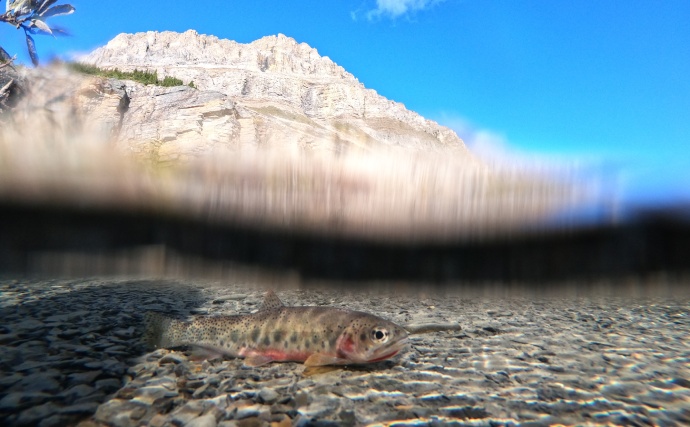
How we got here
Parks Canada began introducing non-native fish, like Brook Trout, into mountain national parks in the 1940s to enhance the visitor fishing experience. This continued until the 1980s, with lasting negative impacts on the ecosystem.
Transcript
[Shelley Humphries] Banff was formed in 1885. And when the early park managers arrived here, a lot of the rivers and lakes didn't have fish.
The fish were not able to recolonize and get up into the mountainous terrain.
So to improve fishing opportunities for people and recreation and give people a reason to visit,
Parks Canada really actively stocked fish all over the place, including many species that didn't belong in Western Canada or even Canada at all.
Now the science and our understanding of what has happened has changed.
And we realize that some of these fish that were stocked in the early days are really detrimental to the longevity and persistence of our native fish, our threatened Westslope Cutthroat Trout and our Bull Trout.
Westslope Cutthroat Trout are also reproducing with non-native trout, like Rainbow Trout and Yellowstone Cutthroat Trout. This is creating hybrid trout populations that are diluting the Westslope Cutthroat Trout gene pool.
Transcript
[Shelley Humphries] Brook Trout are now one of the most common fish in Banff National Park.
They're from Eastern Canada, and they're extremely competitive and capable of outcompeting Westslope Cutthroat Trout and Bull Trout.
And we also stocked Rainbow Trout and even Yellowstone Cutthroat Trout from the United States.
And these two fish are able to hybridize with Westslope Cutthroat Trout, which is part of the reason why this fish is threatened in Western Canada.
Needed by the ecosystem
The native Westslope Cutthroat Trout are fussy fish when it comes to needing cold, clean and fresh water environments. For this reason, they are considered an indicator species—their presence shows that habitats and ecosystems are healthy.
Transcript
[Shelley Humphries] Westslope Cutthroat Trout are an integral part of this ecosystem.
Bears need Westslope Cutthroat Trout. Osprey need Westslope Cutthroat Trout.
The non-native fish that are here are not interchangeable. They don't play the same role.
The Westslope Cutthroat Trout belong here, and we're bringing them back.
Bears and osprey also rely on Westslope Cutthroat Trout for food.
The time of year and location that Westslope Cutthroat Trout spawn is ecologically important. They are food for bears when they come out of hibernation and for ospreys that have migrated here. Their eggs are also accessible to Harlequin ducks when they need food to produce their own eggs.
Non-native trout do not replace the important role that Westslope Cutthroat Trout play in an ecosystem. Non-native Brook Trout spawn in the fall—a time when they are less important to the ecosystem. Their eggs are also buried deeper and are not accessible to higher parts of the food chains.

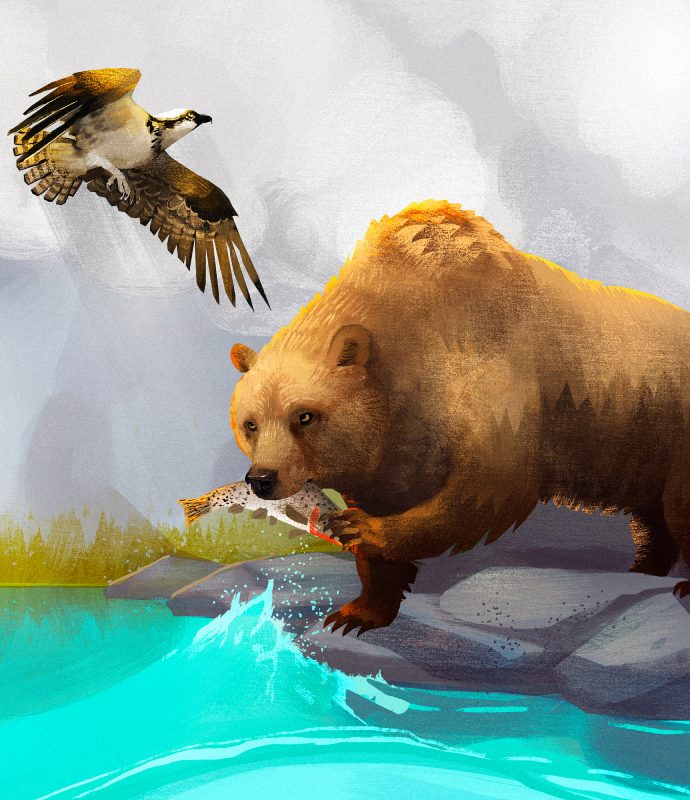
As such, Westslope Cutthroat Trout are important species for transferring energy from aquatic ecosystems to land-based ones.


Where they still swim
Many aquatic habitats located outside of protected areas are being damaged or lost, and climate change is warming waters. Despite this, Westslope Cutthroat Trout still remain in parts of mountain national parks, like:
- Banff National Park in Alberta: genetically pure Westslope Cutthroat Trout remain in less than 10% of historic distribution in Alberta, with only a handful of locations in Banff
- Kootenay and Yoho National Parks in British Columbia: some isolated streams in these two parks still have genetically pure populations of Westslope Cutthroat Trout
Parks Canada is an important partner in recovery efforts for this species at risk. They work with other federal and provincial agencies and key stakeholders to restore native trout.
The long road to recovery
Parks Canada has taken a four-part journey to help restore the Westslope Cutthroat Trout. This journey is not over—their efforts are still underway and will continue into the future. To restore Westslope Cutthroat Trout, Parks Canada aims to:
1. Identify habitat refuges
Parks Canada created a long-term headwater refuge to restore Westslope Cutthroat Trout in Hidden Lake and upper Corral Creek in Banff National Park. This area provides a natural refuge that other non-native trout cannot otherwise get into owing to a natural waterfall. Additional refuges will be identified in the future.

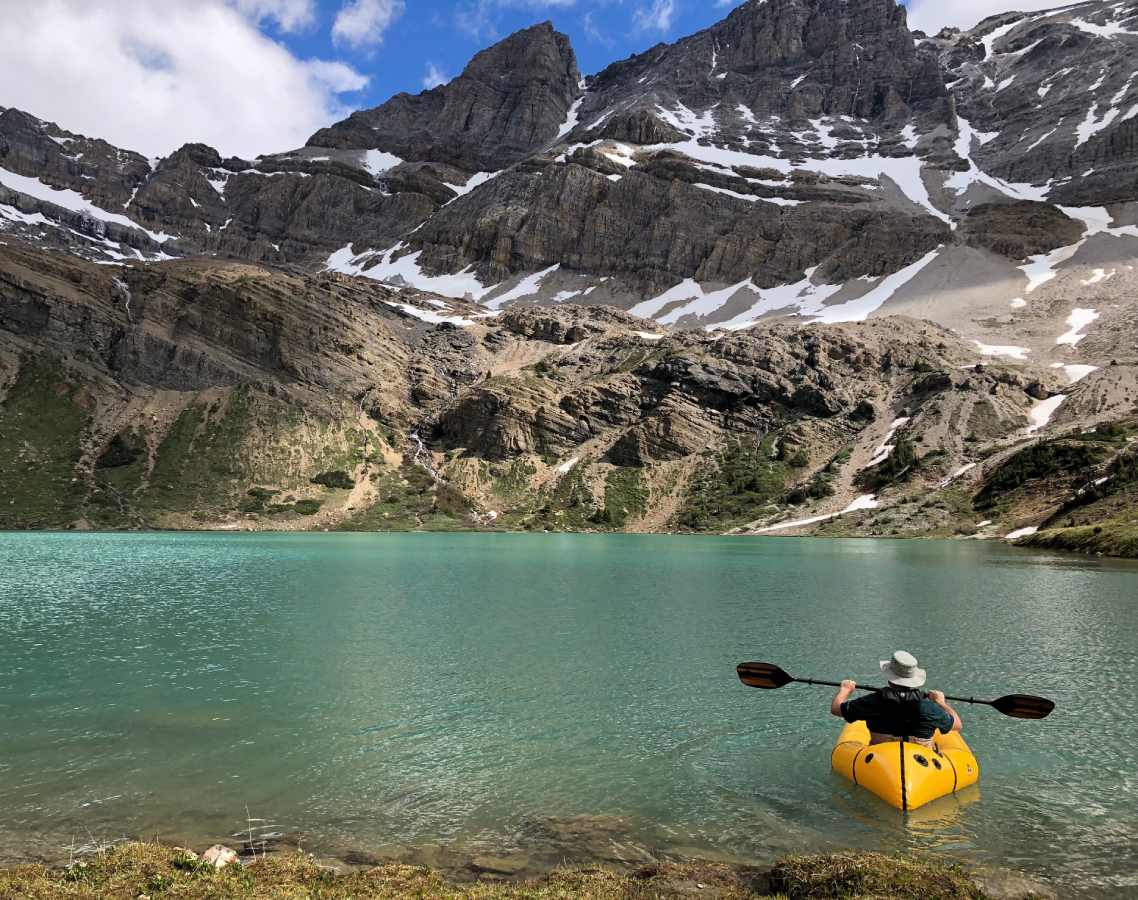
2. Remove non-native fish
Parks Canada worked for six years to remove Brook Trout from the refuge using different methods. They tried netting, electrofishing and angling—but the non-native trout continued to thrive.
So, in 2018, Parks Canada worked with fisheries experts from Canada and Montana to use a naturally-occurring compound called Rotenone to remove the remaining Brook Trout.
Rotenone, a fish toxicant made from the roots of the bean plant, has been used safely and successfully by Indigenous peoples, as well as in Eastern Canada and the US—with no effects on the ecosystem or other species like birds, mammals or people.
Transcript
[Shelley Humphries] The Hidden Lake Basin in Banff is the first place we started a restoration and we started with manual methods, electrofishing, angling and gillnetting.
And after we did it for a few years, we realized it wasn't being successful. We were just making more Brook Trout. We could never stop them from reproducing.
And we knew that if we wanted to be successful here, we needed to change direction and try a new tool.
So we went down to the United States and got some additional training in Montana and in Utah, and they use a compound there that is very effective at removing fish in very small quantities.
And we did a pilot using that compound called rotenone up at Hidden Lake in 2018.
Rotenone is a compound that comes from a plant. It's extracted from bean plants that grow around the equator.
Indigenous groups who live in areas where this plant grows naturally know that they can pick this plant and put it in the water and that it kills fish in very low concentrations.
It's a very safe compound to use because it's only effective against fish in parts per billion and other things that are swimming in the water like zooplankton and phytoplankton.
It has no impact on mammals or birds or people, and it naturally breaks down very quickly in sunlight and in turbulent water, like going over waterfalls, and it doesn't bioaccumulate.
So we also don't have to worry that a fish that has been killed using rotenone will be eaten by a bird and then that bird will get sick.
That doesn't happen at all.
So it really is very unique in that we can use it in very low concentrations and it's naturally breaking down.
Same, but different
The aquatic ecosystem conservation team at La Mauricie National Park in Quebec is faced with a similar but different situation when it comes to restoring their native trout.
While considered an invasive species in Western Canada, Brook Trout are in decline in the eastern part of the country. They are being outcompeted by non-native fish and are facing habitat destruction. Learn more about the restoration efforts to save native trout at La Mauricie.
3. Reintroduce native trout
With the non-native trout populations now under control, Parks Canada has started reintroducing Westslope Cutthroat Trout into the habitat refuge. They are restoring the native trout in partnership with fish culture specialists using a technique called remote stream-side incubation.
Transcript
[Shelley Humphries] We decided to use remote stream incubation as the method to reintroduce fish into the Hidden Lake basin.
We've been working with the Allison Brood hatchery in Southern Alberta, and they take care of the eggs for the first 20 days, and then they give them back to us when they are a little bit bigger and a little bit more mature.
And then we put them back into the lake or stream.
We create these artificial egg nests. They're inside of buckets, and it allows the eggs to finish their next to 10 to 15 days in the water that they're going to live in for the rest of their life.
Although it's challenging to do, it also has really tremendous benefits.
So the first reason we chose it is that it causes the least harm to the very few populations of Westslope Cutthroat Trout we have left because we're not taking adults.
We're just taking some of their eggs and then we bring them back when they're partially mature to the streams that they're going to finish their maturity in and this does a few things.
It helps avoid some of the behavior effects that you get when you raise fish in the hatchery.
They bond onto their home lake or stream. They have better survival.
We're trying to select the most diverse genetics because this diversity in the genetic base is going to give these fish the best chance to survive, especially in the face of some challenges that are coming their way like climate change.
The Aquatics team at Banff National Park install the remote stream-side incubator for the Westslope Cutthroat Trout recovery project. The pipes allow gravity to feed water into the bottom of buckets while water pushes through the top, bringing oxygen to the eggs.
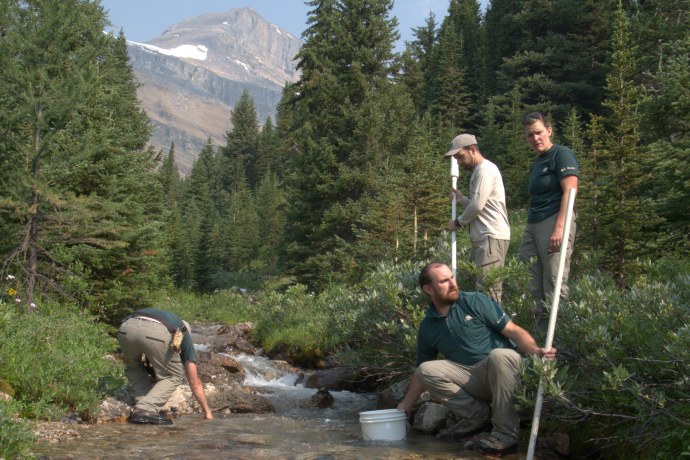

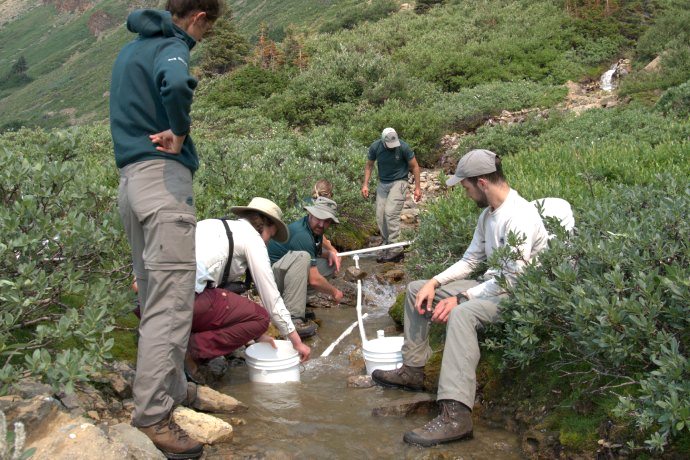

Parks Canada collects eggs and milt from several native trout populations within Banff National Park to maximize potential diversity in the gene pool. An Alberta hatchery incubated the eggs to the ‘eyed stage’ — about halfway through the eggs’ full incubation timeline, when the ova develop visible eyes (seen below). The developed eggs were then sent back to the park, where the final weeks of incubation took place in home waters—literally!
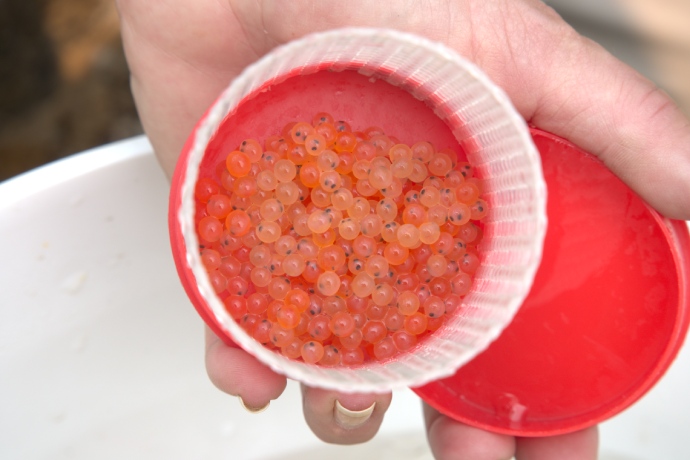
A jar of Westslope Cutthroat Trout eggs at the ‘eyed’ stage of development.

The fish eggs are placed into the instream bucket where they settle in “saddles” that keep them held in the water column, oxygenated on all sides, and separated.
No single agency has enough staff and resources to do this work alone. We rely on outside support. We also don’t want to reinvent the wheel. It's been efficient to study what other agencies in the U.S. are doing and implement their methods. We’ve apprenticed on bigger projects in Montana to get hands-on experience and have learned a lot from their leadership.
Since then, Parks Canada has developed their own incubator to minimize egg transport and handling time, and lower costs. From 2022 onward, the aquatics team will raise the trout throughout all lifecycle stages within the park.
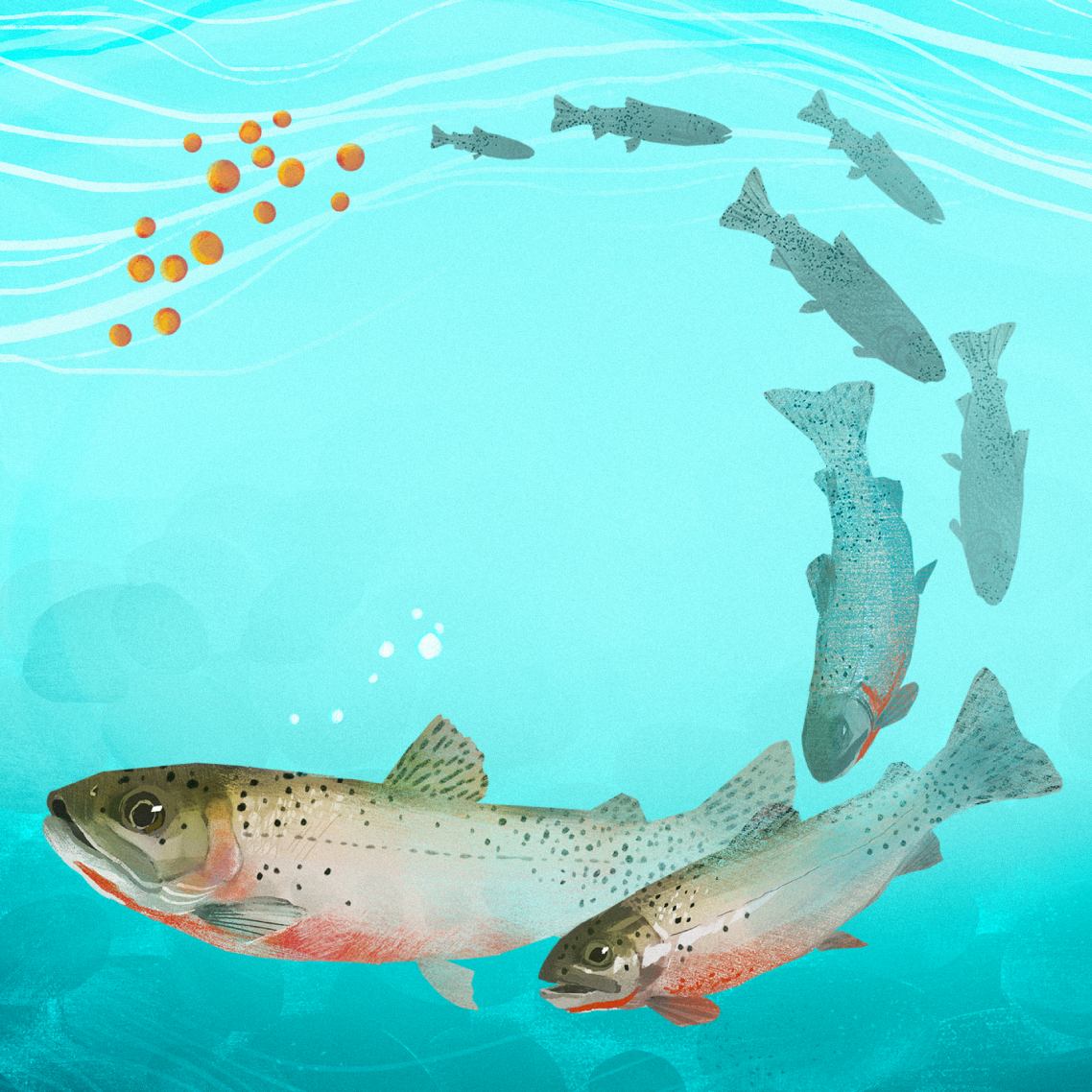
Parks Canada has adapted the Incident Command structure to use as an effective tool for undertaking complex conservation projects on the ground with lots of people.
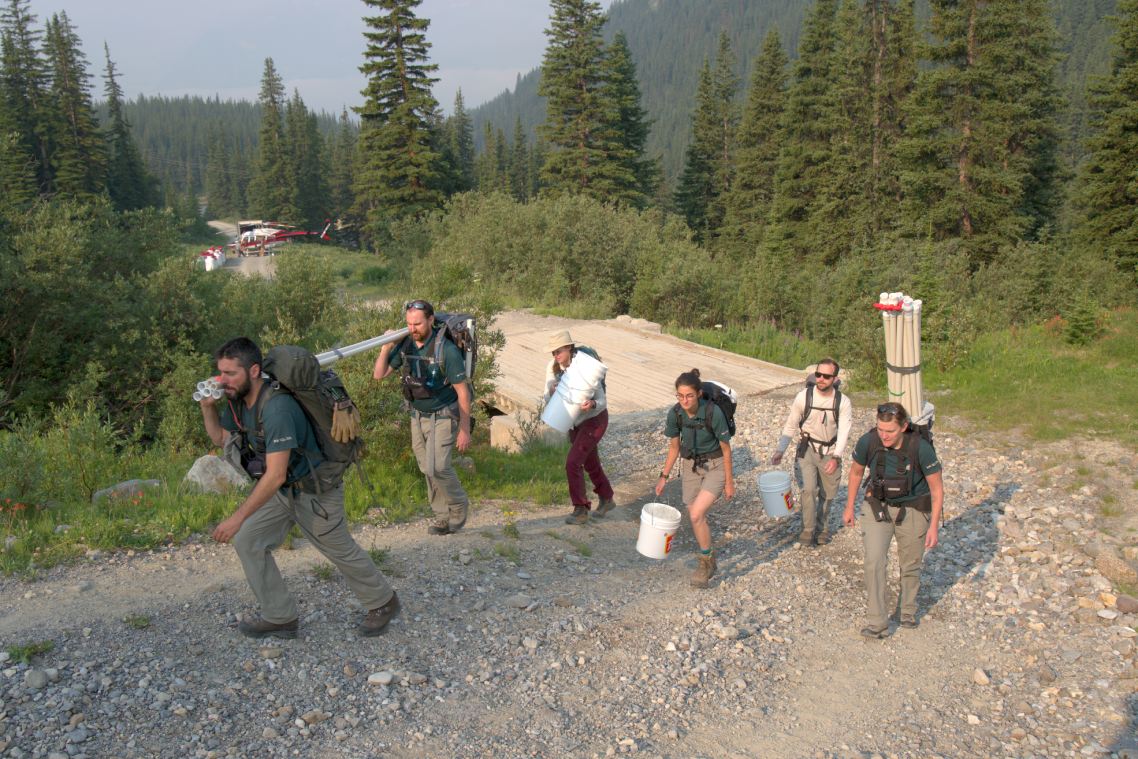
Transcript
[Brad Stitt] It's quite challenging.
The logistics that need to line up in order to get everybody up here, all the equipment up here, need to have redundancy in the equipment, multiple pieces of each type of equipment.
So if something breaks, we can't just run 10k down a hill and grab something and walk it back up.
We need to have everything in hand to be able to go and do the job that we're doing.
It's crucial to conserve and restore these areas for future generations.
I have a new son and I want him to be able to experience all of this.
We're removing fish.
It's not something that we take lightly.
It's tough and it's hard, but it's got to be done.
Parks Canada will place thousands of eggs into Hidden Basin over the next three years or longer. Their intention is to have fish old enough to spawn every year. Thanks to these efforts, Westslope Cutthroat Trout have begun to swim in Hidden Creek for the first time in 50 years!
4. Monitor for success
Parks Canada has successfully restored an 11 ha lake and around 4 km of stream. Aquatics staff use environmental DNA (eDNA) to monitor the restoration work (click on Step 2 for information on eDNA). They also monitor the effects of Rotenone on the ecosystem. To date, no negative effects have been reported.
There’s so much success to celebrate with trout! For one, Banff National Park has extremely high quality habitat— it’s even considered a thermal refuge, a place where cold water will still exist in the face of climate change. I think we’re going to have really good success recovering the Westslope Cutthroat Trout. We want people to support this good work, we want to keep the conversation going!
Your support—and actions—can help save native trout in mountain national parks
- Learn more about Westslope Cutthroat Trout
- Join Parks Canada for a guided tour of Hidden Lake and get to know Westslope Cutthroat Trout up close and personal!
- Help protect this species by obeying fishing regulations
- Know how to correctly identify your catch
- Report poachers
- Share your knowledge with other anglers
- Remember to “Clean, Drain, Dry” in all water recreation
- Clean all mud, sand, plant and animal materials from your boats, paddle boards, and fishing gear
- Drain coolers, buckets, compartments, and other items that may hold water
- Dry completely for 48 hours before entering any river, lake or stream
- Ask questions!
- Contact the Lake Louise, Yoho and Kootenay Region aquatics team with questions. They are happy to help: llykaquatics-aquatiquesllyk@pc.gc.ca

Watch the full video of the journey to restore the Westslope Cutthroat Trout:
Text transcript
0:00 [Music] 0:06 [Shelley Humphries] Banff was formed in 1885,0:08 and when the early park managers
0:11 arrived here, a lot of the rivers
0:13 and lakes didn't have fish.
0:15 The fish were not able to recolonize
0:17 and get up into the mountainous terrain.
0:19 So to improve fishing opportunities for people
0:22 and recreation and give people a reason to visit,
0:25 Parks Canada really actively stocked
0:28 fish all over the place,
0:29 including many species that didn't belong
0:31 in Western Canada
0:33 or even Canada at all.
0:41 Now the science
0:42 and our understanding of what has happened has changed,
0:46 and we realize that some of these fish
0:48 that were stocked in the early days are
0:49 really detrimental to the longevity
0:53 and persistence of our native fish,
0:54 our threatened Westslope Cutthroat Trout
0:56 and our Bull Trout.
0:58 Brook Trout are now one of the most common fish
1:01 in Banff national park.
1:02 They're from Eastern Canada,
1:03 and they're extremely competitive
1:05 and capable of outcompeting Westslope Cutthroat Trout
1:08 and Bull Trout.
1:10 And we also stalked Rainbow Trout
1:12 and even Yellowstone Cutthroat Trout from the United States,
1:15 and these two fish are able to hybridize
1:17 with Westslope Cutthroat Trout.
1:19 Which is part of the reason why
1:20 this fish is threatened in Western Canada.
1:23 The Hidden lake basin in Banff
1:25 is the first place we started a restoration.
1:28 And we started with manual methods,
1:30 electro fishing, angling and gillnetting.
1:34 And after we did it for a few years
1:36 we realized it wasn't being successful.
1:37 We were just making more Brook Trout.
1:39 We could never stop them from reproducing,
1:41 and we knew
1:42 that it if we wanted to be successful here,
1:44 we needed to change a direction
1:46 and try a new tool.
1:47 So we went down to the United States,
1:49 and we got some additional training in Montana
1:51 and in Utah.
1:53 And they use a compound there
1:55 that is very effective
1:57 at removing fish in very small quantities.
2:00 And we did a pilot using that compound,
2:03 called rotenone, up at Hidden lake in 2018.
2:07 Rotenone is a compound that comes from a plant.
2:11 It's extracted from bean plants
2:13 that grow around the equator.
2:15 Indigenous groups who live in areas
2:18 where this plant grows naturally,
2:20 know that they can pick this plant
2:22 and put it in the water
2:23 and that it kills fish in very low concentrations.
2:27 It's a very safe compound to use
2:30 because it's only effective
2:31 against fish in parts per billion,
2:34 and other things that are swimming in the water
2:36 like zooplankton and phytoplankton.
2:38 It has no impact on mammals
2:41 or birds or people,
2:44 and it naturally breaks down very quickly in sunlight
2:47 and in turbulent water like going over waterfalls,
2:50 and it doesn't bio accumulate.
2:52 So we also don't have to worry
2:54 that a fish that has
2:55 been killed using rotenone
2:57 will be eaten by a bird,
2:59 and then that bird will get sick.
3:00 That doesn't happen at all.
3:01 So it's really is very unique in
3:03 that we can use it in very low concentrations,
3:05 and it's naturally breaking down.
3:15 [Brad Stitt] It's quite challenging.
3:16 The logistics that need to line up in order
3:19 to get everybody up here,
3:21 all the equipment up here, need to have redundancy
3:24 and equipment, multiple pieces of each type of equipment.
3:27 So if something breaks,
3:28 we can't just run 10k down a hill
3:31 and grab something and walk it back up.
3:34 We need to have everything
3:35 in hand to be able to go
3:37 and do the job that we're doing.
3:42 It's crucial to conserve
3:44 and restore these areas for future generations.
3:48 I have a new son,
3:49 and I want him to be able to experience all of this.
3:52 We're removing fish.
3:53 It's not something that we take lightly.
3:57 It's tough and it's hard
4:00 but it's got to be done.
4:02 [Shelley Humphries] Westslope Cutthroat Trout
4:03 are an integral part of this ecosystem.
4:05 Bears need Westslope Cutthroat Trout.
4:08 Osprey need Westslope Cutthroat Trout.
4:11 The non-native fish that are here are not interchangeable.
4:14 They don't play the same role.
4:15 The Westslope Cutthroat Trout belong here,
4:17 and we're bringing them back.
- Date modified :